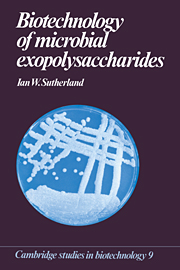Book contents
- Frontmatter
- Contents
- Preface
- 1 Introduction and definition
- 2 Polysaccharide analysis and structural determination
- 3 Exopolysaccharide structure
- 4 Enzymes degrading exopolysaccharides
- 5 Biosynthesis
- 6 Physiology and industrial production
- 7 Genetics, control and regulation of exopolysaccharide synthesis
- 8 Physical properties of exopolysaccharides
- 9 Food usage of exopolysaccharides
- 10 Industrial uses of microbial polysaccharides
- 11 Medical applications of exopolysaccharides
- 12 The future for microbial exopolysaccharides
- References
- Index
3 - Exopolysaccharide structure
Published online by Cambridge University Press: 09 September 2009
- Frontmatter
- Contents
- Preface
- 1 Introduction and definition
- 2 Polysaccharide analysis and structural determination
- 3 Exopolysaccharide structure
- 4 Enzymes degrading exopolysaccharides
- 5 Biosynthesis
- 6 Physiology and industrial production
- 7 Genetics, control and regulation of exopolysaccharide synthesis
- 8 Physical properties of exopolysaccharides
- 9 Food usage of exopolysaccharides
- 10 Industrial uses of microbial polysaccharides
- 11 Medical applications of exopolysaccharides
- 12 The future for microbial exopolysaccharides
- References
- Index
Summary
Introduction
When one considers that the number of microorganisms known to produce exopolysaccharides is very large indeed, the number of structures of these polymers which have been exhaustively studied is still relatively small. As with all polysaccharides, the microbial products can be divided into homopolysaccharides and heteropolysaccharides. Most of the former are neutral glucans; the majority of heteropolysaccharides appear to be polyanionic.
Three types of homopolysaccharide structure are found. Several are linear neutral molecules composed of a single linkage type. (Microorganisms do not appear to yield the ‘mixed linkage’ type of glucan found in cereal plants such as oats and barley.) There are also several polyanionic homopolymers and these, unlike the glucans, also contain acyl groups. Slightly more complex structures are the homopolysaccharides of the scleroglucan type, which possess tetrasaccharide repeating units due to the 1,6-α-D-glucosyl side-chains present on every third main chain residue. Finally, branched homopolysaccharide structures are found in dextrans.
Microbial heteropolysaccharides are almost all composed of repeating units varying in size from disaccharides to octasaccharides. These frequently contain one mole of a uronic acid, which is usually D-glucuronic acid. Very occasionally, two uronic acids are present. The uniformity of the repeat units is based on chemical studies and it is possible that some irregularities may be found, especially in the polymers composed of larger and more complex repeat units. The heteropolymers commonly possess short side-chains, which may vary from one to four sugars in length. Very rarely, the side-chains themselves may also be branched.
- Type
- Chapter
- Information
- Biotechnology of Microbial Exopolysaccharides , pp. 20 - 37Publisher: Cambridge University PressPrint publication year: 1990
- 1
- Cited by

